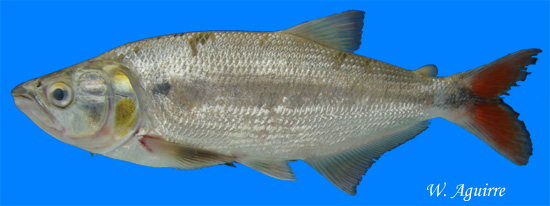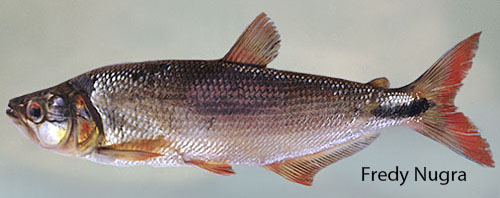Characidae - Brycon alburnus (Gunther 1860) |
 |  |
| SOURCE FOR OCCURRENCE IN ECUADOR: This species is very common in the Guayas and Esmeraldas rivers. There are many references for its occurrence in the area (e.g., Eigenmann, 1922; Böhlke, 1958; Ovchynnyk, 1971; Gery, 1977; Glodek, 1978; Howes, 1982; Laaz & Torres, 2010). |
| ORIGINAL DESCRIPTION: Gunther, A. 1860. Second list of cold-blooded vertebrata collected by Mr. Fraser in the Andes of western Ecuador. Proceedings of the General Meetings for Scientific Business of the Zoological Society of London 1859(pt 3):402-420. |
| TYPE SPECIMENS: |
| TAXONOMIC STATUS: Valid (Eschmeyer and Fricke, 2011). Howe (1982) indicates that Brycon acutus, described from Esmeraldas province, is a synonym of B. alburnus. |
| RANGE ECUADOR: Guayas River drainage. Howes (1982) lists it as occurring in the Esmeraldas River as well. |
| RANGE OUTSIDE OF ECUADOR: None. |
| COLLECTIONS IN ECUADOR: |
| MAXIMUM SIZE: 32.6 cm SL (Fishbase, 2011). |
| DISTINGUISHING FEATURES: Brycon alburnus differs from other species in the genus in lacking a premaxillary symphysial joint. The premaxillaries are separated by the elongate supraethmoid and are joined syndesmotically. The species also possesses a dental morphology different from its congeners. Brycon alburnus' longer snout can distinguish it from B. atrocaudatus. Brycon alburnus typically has iv28-iv30 anal fin elements while B. dentex typically has iv31-iv32 and B. oligolepis typically has iv25-iv28 anal fin elements (Howes, 1982). |
|
 |
Top: Brycon alburnus. Middle: Brycon atrocaudatus. Bottom: Brycon dentex. Note differences in body shape and head shape, particularly snout length and dentition. Brycon alburnus has a long snout with large teeth, including canine like teeth. Brycon atrocaudatus has a snout of intermediate length with regular peg-like teeth. Brycon dentex has a short snout with small teeth. All specimens were purchased from fishermen in Santa Rosa, El Oro Province, southwestern Ecuador.
|
|
| ECOLOGY: Brycon alburnus, known in Ecuador as the “dama”, is a large, ecologically important omnivorous fish. |
| ECONOMIC IMPORTANCE: This is an important food fish for people in rural parts of western Ecuador (Revelo, 2010). |
| CONSERVATION STATUS: NA, although this is an important food fish in western Ecuador. |
| LINK TO FISHBASE PAGE: Click here for link |
| SPECIES PROFILE CREATED BY: Enrique Laaz |
| SPECIES PROFILE CONTRIBUTORS: Windsor Aguirre |
|
|
|
|
|

